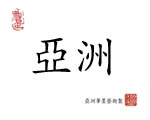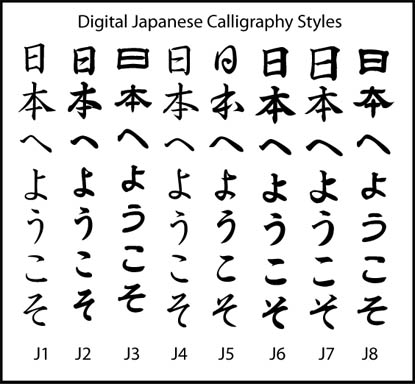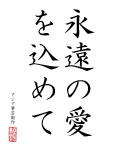
|
Custom Calligraphy (via Digital Files or Handbrushed on Traditional Rice Papers) |
|---|
-------------------------------------------- Custom Stamps and Seals (Via Machine / Hand Carved) |
Marble Seals
|
|---|
--------------------------------------------
Custom Asian Theme Graphic Design (Design/Printing ) |
-------------------------------------------- Commercial Use Designs (Web, Magazine, Display Booth, Newspaper, Ads and Promotions) |
|---|
-------------------------------------------- Decorations Scrolls & Calligraphy Supply |
|---|
-------------------------------------------- Other Services & Specials |
Japanese Calligraphy via Digital Files
You may order names or short phrases as a digital file only order. Processing times are fast (generally 2-3 business days) and images may be used in a variety of non-commercial applications from non-bussiness websites to tattoos. Images are sent as JPEG in 100 dpi resolution.
Business use quality resolution of 300 dpi or higher upon request with business use rate. May request different file formats.
You may choose your translation in Japanese Kanji or Japanese Katakana/Hiragana. How does Japanese language works? How does Hiragana, Katakana and Kanji used? How Is the translation done?
Digital Calligraphy Pricing in US Dollars
(Personal Use 100 dpi Resolution JPEG Rate)
| 1 Style | 2 Styles Pack | 3 Styles Pack | |
|---|---|---|---|
| Single name or word | $20.00
|
$35.00 |
$45.00 |
| First & Last name/ | $25.00 |
$40.00 |
$55.00 |
| Single phrase up to 4 words | $30.00 |
$50.00 |
$65.00 |
| Single phrase up to 8 words | $40.00 |
$60.00 |
$75.00 |
| Single phrase up to 10 words | $50.00 |
$80.00 |
$105.00 |
| Single phrase up to 15 words | $60.00 |
$100.00 |
$120.00 |
| 16 and above words |
To Order Japanese Calligraphy via Digital Format
Please place your order or get a quote via order@AsianBrushArt.com
We will contact within 48 business hours. If you have not received a reply from us, please double check your spam folder. Please also try emailing us again, if possible, give us an alternate email address to contact you. Thank you!
----------------------
Please Provide The Following:
-
Your name:
-
Billing address:
-
Calligraphy style to be used: (See font style J1 - J8)
-
Text to be translated: Word/Name/Phrase you want to be translated in Korean
-
Layout: Vertical or Horizontal
-
Image quality resolution: Above quote is for Personal Use 100 dpi JPEG format. (Professional 300 dpi and up Special Quote will needed, let us know your file format preference.)

Style J1
----------------------------------------


Style J2
----------------------------------------

Style J5
----------------------------------------
Style J8
How does Japanese Language works? The Japanese language uses three different characters system. Though, the modern Japanese text is written with a mixture Hiragana, Katakana and Kanji. However, each writing is used in a somewhat different.Non-Japanese names are usually translated with Katakana characters. Hiragana
The hiragana system consists of 46 syllables and is mainly used to write word endings. Each character represents a sound, it is a syllabic alphabet Hiragana are also widely used in any text materials for children, adults, textbooks and books. It is also used to write Japanese words that are not normally written with kanji. For example, adjectives, adverbs and some nouns, or for words whose kanji are obscure or obsolete. For this reason, usually when translating an English phrase into Japanese Kanji, the Japanese phrase may contain some Hiragana. Katakana
Kanji  Kanji is the Japanese name of the Chinese word hanzi, which means "Han characters". (Han refers to the Han Dynasty 206BC - 220AD) As most Kanji have several meanings and pronunciations. So, it is not always obvious, which meaning or pronunciation the characters are intended to mean/be. Even to a native Japanese speaker. Sometimes Furigana (a Japanese reading aid. They consist of smaller kana printed next to a kanji or other character to indicate its pronunciation) are used for clarification. However, when there!|s no Furigana, then it is only the context and the reader's experience can provide clues. This could sometimes make it a little more difficult to translate Japanese kanji. |
|---|






